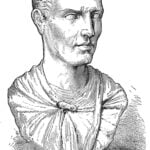The ancients were keenly interested in the past. The stories of the mythical Trojan War and the return of the heroes from Troy to their homes throughout the epoch were a source of entertainment for both aristocrats and ordinary bread eaters, and inspiration for sculptors and poets.
Stories about heroes physically different from later humans gave rise to reflections on the majestic appearance of their ancestors, who were to be more beautiful and much taller than the average Greek or Roman. Asumptu for this type of consideration were given by descriptions of characters in Iliad and Odyssey, the inseparable element of which is admiration for greatness and beauty, e.g. Telemachus (Odyssey, book III, verses 204- 6). For people from the archaic era (8th-5th century BCE), corporeality was one of the determinants of status, which can be clearly seen in one of the scenes of the Odyssey. The goddess Athena, wishing to add splendour to Odysseus, gave him height and muscles, which the king of Ithaca inspired respect in the people watching him (From, book VIII, verses 18-23). Hesiod in Works and Days, his didactic work, in addition to many tips for a good life, included a story about the so-called human ages (golden, silver, bronze, heroic and then Hesiod – iron age). With each successive age, mankind has degenerated more and more, thus having less and less in common with the gods. One of the manifestations of the fall was precisely less growth, but also ugliness (Hesiod, Works and Days, verse 106 et seq.). It is worth looking at the later tales of finding giant skeletons, thus confronting the beliefs of people existing in the following centuries, about the truthfulness of Homer and Hesiod’s words about giant heroes.
Pausanias, a traveller from the 2nd century CE, describing many lands on which he walked, presented not only buildings encountered during the journey, but also stories heard from local people. He mentioned, among others about the mighty Ajax, a hero from Troy, whose body was allegedly found by the sea that washed the tomb of the hero. The man reporting to Pausanias about the discovery of Ajas’ body, wanting to show the size of the skeleton, compared the size of his kneecap (i.e. the knee bone) to the disk thrown by discobolics. Similarly, in Miletus, thanks to the destructive power of water, find the name of the giant Asterios, son of Anax, and Gea (or the goddess of the Earth), whose skeleton measured ten cubits. In Lydia, in turn, the massive remains of Geryon were found – the same that Heracles killed in order to steal his oxen and thus fill one of the so-called twelve works (Pausanias, Travels in Hellas, book I, chapter 35, paragraphs 5-8).
One of the most memorable works by Cimon, an Athenian politician in the 5th century BCE, was to be the miraculous finding of the corpse of the hero – Theseus, about which we can read in the work of Plutarch of Chaeronea, who lived at the turn of the 1st and 2nd centuries CE. By divine inspiration, Kimon knew where to dig on the island of Skiros, where Theseus was to die, and after finding the huge skeleton, he had no doubts that he had found a hero from old age. All this allowed him to return in glory to Athens, where he was laid in the heart of the city in a tomb that was also the sanctuary of the hero (Plutarch, The Life of Theseus, chapter 36).
Flavius Philostratus, who lived at the turn of the 2nd and 3rd centuries CE, who was active in the circle of intellectuals created by the wife of Septimius Severus (Julia Domna), also believed similar stories. As a digression, he mentioned in his greatest work, i.e. in The Life of Apollonius of Tyana, describing the colourized life of a Pythagorean philosopher active in the 1st century CE, about the bodies of giants that can be found in the event of the destruction of their graves (Flavius Philostratus, The Life of Apollonius, book V, chapter 16). Flavius also signalled his belief in the supernaturally tall people of the past in another work. In his A Conversation about Heroes he showed many ancient matters concerning the heroes of the Trojan War, to which Homer did not provide an exhaustive answer. The main informant about the world of Homeric epics was Protesilaus, whom Flavius described as a young man ten cubits high, with a very handsome face (Flavius Philostratus, A Conversation on Heroes, Chapter 10).
These and many other stories are important testimonies. They show that, in addition to the intellectual narrative about the imaginary world of Homeric epics, many repeated with faith the stories of finding the several-meter-high skeletons of heroes from the Trojan War, thus trusting the old legends.







